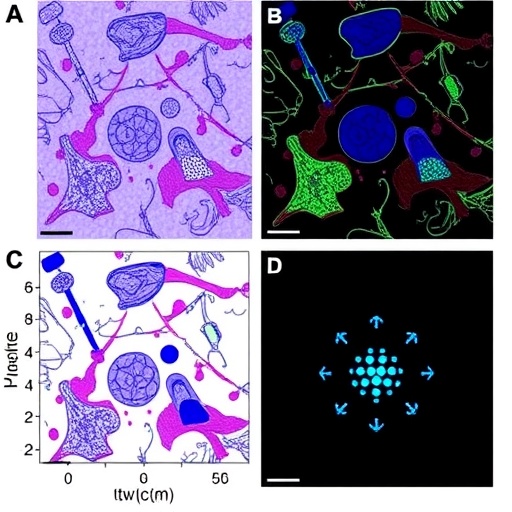In a groundbreaking advancement at the intersection of oncology and photomedicine, recent research has illuminated the promising synergy between photodynamic therapy (PDT) and the chemotherapeutic agent oxaliplatin in the battle against cervical cancer. This innovative study reveals that the integration of PDT with oxaliplatin treatment not only amplifies cancer cell eradication efficacy but also intricately modulates genes linked to cellular stemness, a crucial factor in tumor progression and resistance.
Cervical cancer remains a major global health challenge, characterized by its aggressive nature and frequent resistance to conventional chemotherapies. Oxaliplatin, a platinum-based drug commonly employed in various solid tumors, has shown varied effectiveness in cervical cancer treatment. The novel approach of pairing oxaliplatin with photodynamic therapy—where light-activated compounds induce precise cytotoxic effects—marks a significant shift toward more targeted, efficacious interventions.
Photodynamic therapy operates by utilizing photosensitizing agents that, upon activation by specific wavelengths of light, generate reactive oxygen species leading to cancer cell death. Unlike systemic chemotherapy, PDT offers spatial control and minimizes off-target damage, a critical advantage in preserving healthy tissue. By exploring the combined effect of PDT and oxaliplatin, researchers have aimed to transcend the limitations of single-modality treatments.
The research zeroes in on the molecular landscape of cervical cancer cells, focusing specifically on stemness-related genes. These genes govern the properties of cancer stem cells, a subpopulation within tumors renowned for their ability to self-renew and resist conventional therapies. Modulating these genes could disrupt the tumor’s regenerative capacity and mitigate relapse risks.
Experimental findings from cell-based assays reveal a remarkable enhancement in the anti-proliferative effects when oxaliplatin is applied alongside photodynamic therapy. The dual treatment induced significant cytotoxicity, surpassing the effects observed with oxaliplatin monotherapy. This enhanced cell death is attributed to the synergistic activation of apoptotic pathways triggered by oxidative stress from PDT combined with DNA damage inflicted by oxaliplatin.
Importantly, gene expression profiling demonstrated a pronounced downregulation of key stemness markers such as SOX2, NANOG, and OCT4 following combined treatment. The suppression of these transcription factors, central to maintaining cancer stem cell phenotypes, suggests a molecular mechanism by which the therapy undermines tumor resilience and aggressiveness.
By attenuating stemness properties, the therapy could effectively reduce the tumor’s capacity for metastasis and recurrence, two hallmarks of poor prognosis in cervical cancer patients. This molecular reprogramming opens a new front in anti-cancer strategies focusing not only on tumor bulk reduction but also on eradicating the root of cancer perpetuation: cancer stem cells.
The implications of these findings extend beyond laboratory models. The potential clinical application of PDT-enhanced oxaliplatin therapy could revolutionize treatment protocols, offering a dual-threat mechanism: the direct cytotoxicity of chemotherapy paired with the localized, controlled damage orchestrated by light activation.
Additionally, the study provides a framework for safer, more personalized medicine. PDT’s precision limits systemic toxicity, potentially reducing the harsh side effects commonly associated with platinum-based chemotherapy. This improves patient quality of life and adherence to treatment regimens, crucial factors for successful cancer management.
Beyond cervical cancer, the modulation of stemness genes through combined treatment heralds possibilities for other malignancies where cancer stem cells drive resistance and recurrence. Researchers are poised to investigate similar therapeutic paradigms in tumors such as breast, colon, and lung cancers, thereby broadening the impact of this approach.
Furthermore, the molecular intricacies unraveled in this research contribute to a deeper understanding of the interplay between cancer treatments and tumor cell biology. The dual targeting of proliferative mechanisms and cancer stem cell pathways exemplifies a sophisticated, multi-layered strategy that may set a precedent in oncological therapeutics.
This trajectory of integrating photochemical methods with established chemotherapeutic agents symbolizes a promising horizon where multi-modal therapies tackle cancer heterogeneity and treatment resistance head-on. The advancement underscores the importance of interdisciplinary research in crafting tomorrow’s cancer solutions.
As this innovative therapeutic framework progresses toward clinical trials, the oncology community watches with anticipation. Success in translational studies could herald a pinnacle in cervical cancer care, drastically improving survival rates while minimizing collateral damage.
In conclusion, the confluence of photodynamic therapy and oxaliplatin unveils a powerful, synergistic mechanism in combatting cervical cancer by targeting not only proliferating tumor cells but also the foundational cancer stem cells via stemness-related gene regulation. This discovery marks a significant stride toward more effective, less toxic cancer treatments, potentially transforming therapeutic landscapes and patient outcomes worldwide.
Subject of Research:
The study investigates the synergistic effect of photodynamic therapy combined with oxaliplatin treatment on cervical cancer cells, focusing on the regulation of stemness-related genes to enhance anti-proliferative activity.
Article Title:
Photodynamic therapy boosts the anti-proliferative activity of oxaliplatin in cervical cancer cells by regulating stemness-related genes
Article References:
Lahouti, S., Doustvandi, M.A., Yari, A. et al. Photodynamic therapy boosts the anti-proliferative activity of oxaliplatin in cervical cancer cells by regulating stemness-related genes. Med Oncol 42, 514 (2025). https://doi.org/10.1007/s12032-025-03047-y
Image Credits: AI Generated
Tags: advancements in oncology and photomedicinecancer cell eradication techniquescervical cancer resistance to chemotherapyinnovative cancer treatment approacheslight-activated cancer treatment methodsmultimodal strategies for cervical canceroxaliplatin chemotherapy effectivenessPhotodynamic therapy for cervical cancerreactive oxygen species in cancer therapystemness modulation in tumorssynergy of PDT and oxaliplatintargeted cancer therapies with PDT





